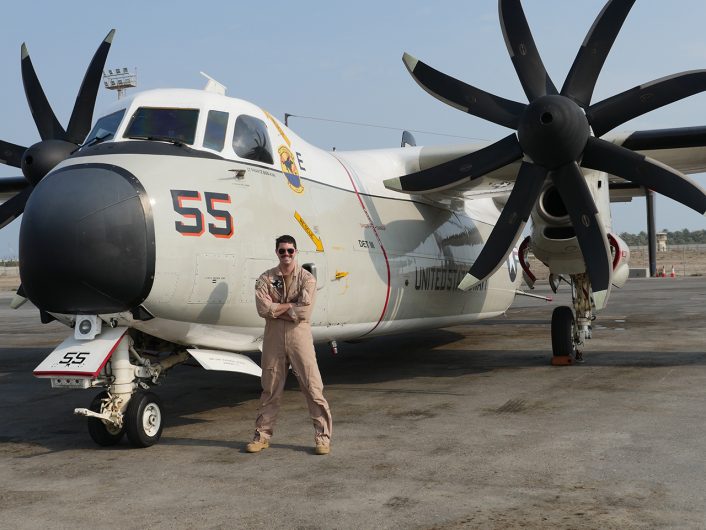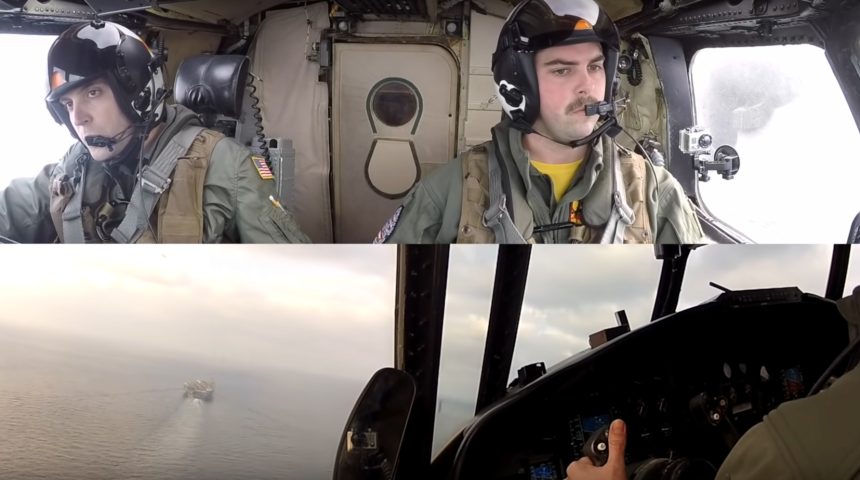This video from a U.S. Navy pilot really gives an idea of the amount of mental focus required to perform a trap landing on an aircraft carrier.
Rob Roy is an active duty U.S. Navy pilot. He’s logged 1,000 flight hours, 135 arrested landings, including 75 as the PIC (Pilot In Command), flying the C-2A(R) Greyhound with the Fleet Logistics Support Squadron 40 (VRC-40) “Rawhides”, one of only two active fleet logistics squadrons in the Navy (the other being VRC-30). The Grumman C-2A Greyhound is a twin-engine, high-wing cargo aircraft, designed to perform the COD (Carrier Onboard Delivery) mission: it carries equipment, passengers (including occasional distinguished visitors) supplies and mail to and from U.S. Navy aircraft carriers. And, considered its size, the Greyhound is, among all the other things, also one of the most difficult aircraft to land on a flattop.
A few years ago, during one of the multiple daily COD missions to the USS Harry S. Truman aircraft carrier operating in the Persian Gulf, Rob has also filmed the interesting video below (that is even more amazing because, once again, edited in a split screen format so that you can get an idea of both the view from the cockpit and the gestures, movements and efforts of the aircrew during a trap landing).
Pay a special attention to his eyes once he rolls on short final and flies the “ball”, i.e. the Optical Landing System (OLS), also known as the “meatball”, a system of lights installed on the carrier used to give glidepath information to pilots in the final approach phase of the landing on an aircraft carrier.
“This video was actually recorded while I was on deployment and at a time in my flying career when I really started to feel comfortable behind the boat. So much so, that we were definitely pushing the envelope on this particular pass (for as much as you can in a C-2, ha!) by coming in fast and breaking extremely early,” Rob told us in an email.
“Typically for a carrier break in an E-2 or C-2, you turn about one mile past the ship. For this pass though, it might have been 1/5 that distance. This is why I’m repeatedly looking out the window, as I’m trying to gauge just how far abeam we are from the boat and making sure that we are setting ourselves up to intercept a typical approach turn portfolio, which finally occurs just before I get on glide slope and start flying the ball.”
“Also, the co-pilot in this video is an incredibly skilled pilot who was senior to me at the time. He backed me up throughout the entire approach and I absolutely could not have successfully attempted this pass without him.”
“And it’s been a few years since this video was recorded, but I miss flying on and off of aircraft carriers every day.”

Initially scheduled to be retired in 2027, the C-2A(R) will be eventually retired in 2024, when the last squadron is expected to phase out the Greyhound. The U.S. Navy is getting 39 CMV-22 out of 58 Ospreys included in a 4.2B USD contract signed by the Pentagon in 2018 to fully replace the C-2 fleet. The first operational CMV-22B Osprey configured for the COD role was delivered to the U.S. Navy on June 22, 2020. The aircraft, registration #169437, is assigned to Fleet Logistics Multi-Mission Squadron 30 (VRM-30) “Titans” at Naval Air Station North Island. The Titans are the first CMV-22B squadron that was stood up in December 2018, a year before the first flight of the “CODsprey” (as some nicknamed the new aircraft), and they will receive 18 aircraft in total.
On Nov. 22, 2020, a CMV-22B tilt-rotor aircraft of the Fleet Logistics Multi-Mission Squadron 30 (VRM-30) “Titans” at Naval Air Station North Island conducted the first ever Navy COD (Carrier On-board Delivery) variant of the Osprey landings and take-offs from an aircraft carrier (USS Carl Vinson).
A big “Thank You!” to Rob for sharing his experience and video with us. Make sure you visit his website robroyoutdoors.com. His podcast called “Adventure Bound” is available on Apple Podcasts and Spotify.









